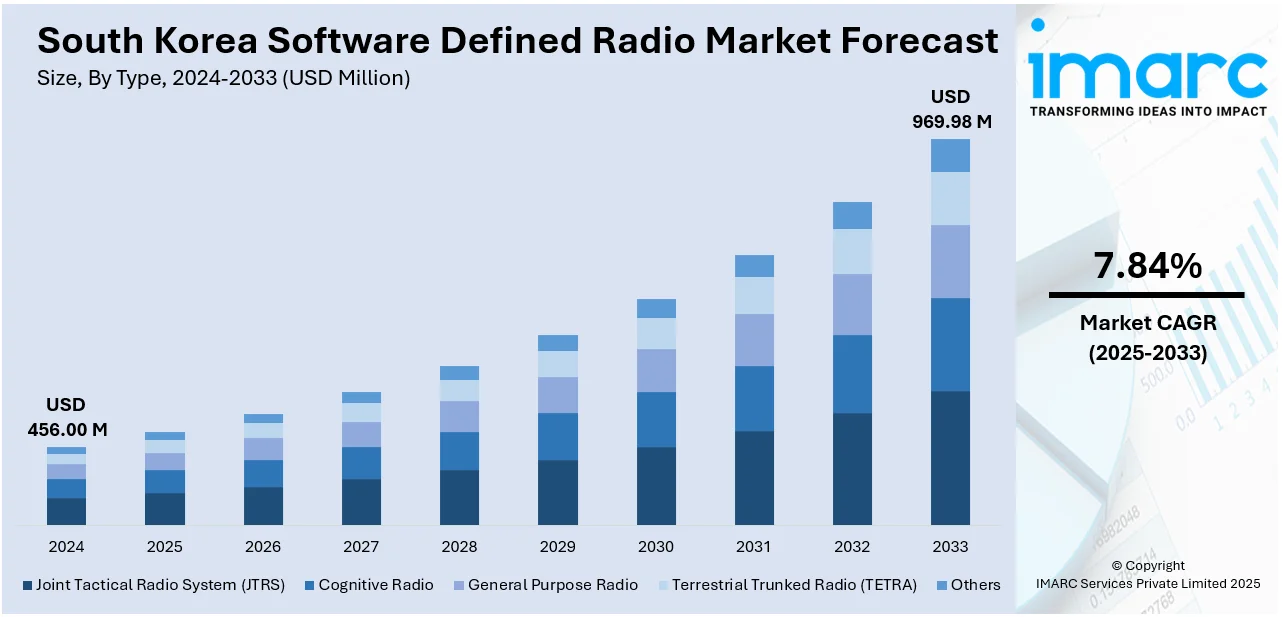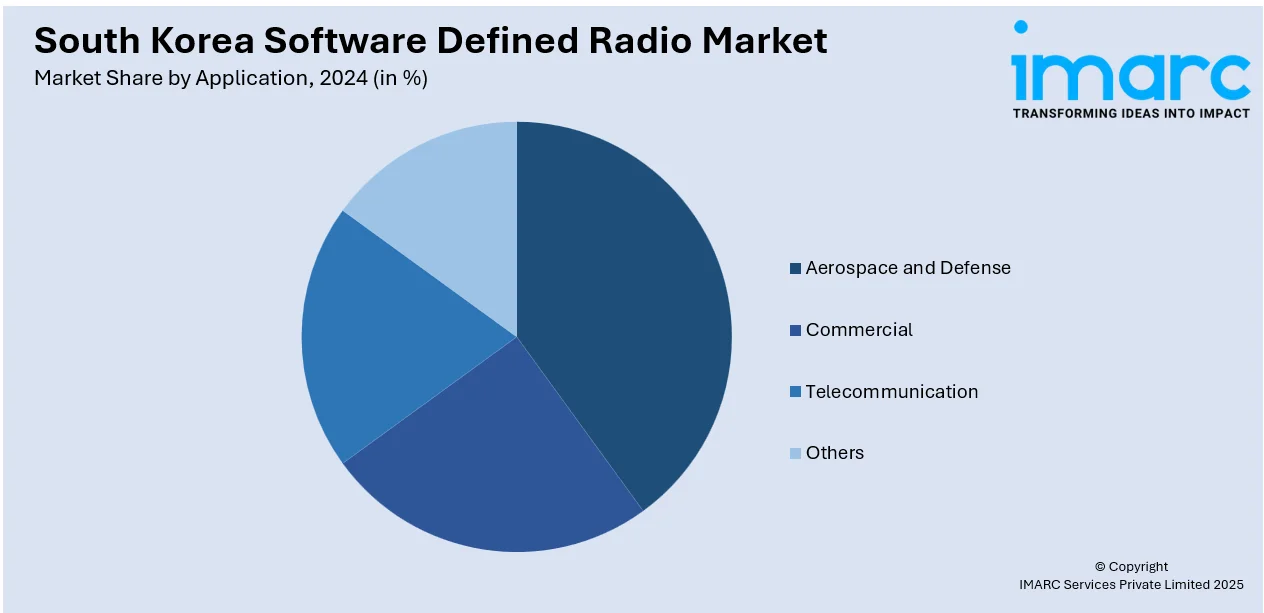
South Korea Software Defined Radio Market Size, Share, Trends and Forecast by Type, Application, Component, Platform, Frequency Band, and Region, 2025-2033
South Korea Software Defined Radio Market Overview:
The South Korea software defined radio market size reached USD 456.00 Million in 2024. Looking forward, IMARC Group expects the market to reach USD 969.98 Million by 2033, exhibiting a growth rate (CAGR) of 7.84% during 2025-2033. The market is driven by telecom advancements and rising cybersecurity needs. Software defined radio offers adaptable, efficient communication systems for evolving 5G/6G networks and robust security against rising cyber threats. Its flexibility, scalability, and remote update capabilities support national goals for secure, high-performance infrastructure, thereby increasing the South Korea software defined radio market share.
|
Report Attribute
|
Key Statistics
|
|---|---|
|
Base Year
|
2024
|
|
Forecast Years
|
2025-2033
|
|
Historical Years
|
2019-2024
|
| Market Size in 2024 | USD 456.00 Million |
| Market Forecast in 2033 | USD 969.98 Million |
| Market Growth Rate 2025-2033 | 7.84% |
South Korea Software Defined Radio Market Trends:
Advancement of Telecommunication Infrastructure
The evolution of South Korea's telecommunications sector is driving the widespread adoption of software defined radio (SDR) technology. The advent of 5G and future 6G networks is leading to a growing need for adaptable communication systems that can support high bandwidth, minimal latency, and broad coverage. SDR enables telecom companies to flexibly oversee spectrum, utilize resources effectively, and modify network setups to satisfy user needs. This flexibility is essential for South Korea’s aim of preserving its dominance in international telecom infrastructure. SDR provides notable benefits regarding cost savings and operational efficiency, allowing telecom firms to execute remote updates and software-driven network configuration. These features guarantee network durability and aid in the swift rollout of future services. A notable instance is South Korea's Stage X project in 2024, which intended to implement a national 5G network by the middle of 2025. With an investment of $462 million, Stage X aimed to install 6,000 base stations utilizing the 28 GHz spectrum, a step that matches the nation's larger vision for a high-performance, future-oriented telecom network. In this scenario, SDR is considered a crucial solution for ensuring the longevity of these networks, providing scalability, adaptability, and effortless integration with new wireless technologies such as 5G and 6G. This trend highlights a promising trajectory for software defined radio market growth, as telecom providers increasingly rely on SDR to meet evolving technological and infrastructural demands.

To get more information on this market, Request Sample
Demand for Enhanced Cybersecurity
The rising emphasis on cybersecurity is greatly propelling the advancement of SDR technology in South Korea. With cyber threats growing more sophisticated and frequent, the public and private sectors are emphasizing the security of communication networks. SDR systems provide important features, such as strong encryption, frequency hopping, and the capability to effortlessly update security protocols through software, rendering them vital for protecting sensitive information in defense, telecommunications, and finance industries. In an area where digital conflict and spying are rising issues, South Korea is adopting SDR to ensure secure, robust, and adaptable communication systems. This technology offers tailored security solutions that enable the nation to remain proactive against emerging cyber threats. The Korea Internet & Security Agency (KISA) reported a 48 percent rise in cyber incidents in 2024, growing from 1,277 to 1,887 occurrences. This increase emphasizes the rising demand for advanced and flexible security solutions. SDR's capability to quickly incorporate new security features, along with its adaptable communication, makes it an essential element in South Korea's national cybersecurity plan. As cyber threats escalate, SDR technology is not only bolstering network security but also guaranteeing that South Korea’s communication infrastructure stays robust and prepared for the growing complexity of digital assaults.
South Korea Software Defined Radio Market Segmentation:
IMARC Group provides an analysis of the key trends in each segment of the market, along with forecasts at the country and regional levels for 2025-2033. Our report has categorized the market based on type, application, component, platform, and frequency band.
Type Insights:
- Joint Tactical Radio System (JTRS)
- Cognitive Radio
- General Purpose Radio
- Terrestrial Trunked Radio (TETRA)
- Others
The report has provided a detailed breakup and analysis of the market based on the type. This includes joint tactical radio system (JTRS), cognitive radio, general purpose radio, terrestrial trunked radio (TETRA), and others.
Application Insights:

- Aerospace and Defense
- Commercial
- Telecommunication
- Others
A detailed breakup and analysis of the market based on the application have also been provided in the report. This includes aerospace and defense, commercial, telecommunication, and others.
Component Insights:
- Transmitter
- Receiver
- Auxiliary System
- Software
The report has provided a detailed breakup and analysis of the market based on the component. This includes transmitter, receiver, auxiliary system, and software.
Platform Insights:
- Land
- Airborne
- Naval
- Space
The report has provided a detailed breakup and analysis of the market based on the platform. This includes land, airborne, naval, and space.
Frequency Band Insights:
- High Frequency
- Very High Frequency
- Ultra-High Frequency
- Others
A detailed breakup and analysis of the market based on the frequency band have also been provided in the report. This includes high frequency, very high frequency, ultra-high frequency, and others.
Regional Insights:
- Seoul Capital Area
- Yeongnam (Southeastern Region)
- Honam (Southwestern Region)
- Hoseo (Central Region)
- Others
The report has also provided a comprehensive analysis of all the major regional markets, which include Seoul Capital Area, Yeongnam (Southeastern Region), Honam (Southwestern Region), Hoseo (Central Region), and others.
Competitive Landscape:
The market research report has also provided a comprehensive analysis of the competitive landscape. Competitive analysis such as market structure, key player positioning, top winning strategies, competitive dashboard, and company evaluation quadrant has been covered in the report. Also, detailed profiles of all major companies have been provided.
South Korea Software Defined Radio Market News:
- In January 2025, NIST hosted Korean researchers to explore 6G security and demonstrated its 5G/6G core network testbed, which includes software-defined radios (SDRs) for physical RAN implementations. The testbed supports customizable deployments and performance testing using Docker-based automation.
- In July 2024, BAE Systems received contracts worth $111 million to supply South Korea with ARC-232A SATURN-capable software-defined radios. These radios enhanced secure, anti-jam communication for South Korea's fixed- and rotary-wing aircraft, supporting NATO interoperability and tactical mission effectiveness.
South Korea Software Defined Radio Market Report Coverage:
| Report Features | Details |
|---|---|
| Base Year of the Analysis | 2024 |
| Historical Period | 2019-2024 |
| Forecast Period | 2025-2033 |
| Units | Million USD |
| Scope of the Report |
Exploration of Historical Trends and Market Outlook, Industry Catalysts and Challenges, Segment-Wise Historical and Future Market Assessment:
|
| Types Covered | Joint Tactical Radio System (JTRS), Cognitive Radio, General Purpose Radio, Terrestrial Trunked Radio (TETRA), Others |
| Applications Covered | Aerospace and Defense, Commercial, Telecommunication, Others |
| Components Covered | Transmitter, Receiver, Auxiliary System, Software |
| Platforms Covered | Land, Airborne, Naval, Space |
| Frequency Bands Covered | High Frequency, Very High Frequency, Ultra-High Frequency, Others |
| Regions Covered | Seoul Capital Area, Yeongnam (Southeastern Region), Honam (Southwestern Region), Hoseo (Central Region), Others |
| Customization Scope | 10% Free Customization |
| Post-Sale Analyst Support | 10-12 Weeks |
| Delivery Format | PDF and Excel through Email (We can also provide the editable version of the report in PPT/Word format on special request) |
Key Questions Answered in This Report:
- How has the South Korea software defined radio market performed so far and how will it perform in the coming years?
- What is the breakup of the South Korea software defined radio market on the basis of type?
- What is the breakup of the South Korea software defined radio market on the basis of application?
- What is the breakup of the South Korea software defined radio market on the basis of component?
- What is the breakup of the South Korea software defined radio market on the basis of platform?
- What is the breakup of the South Korea software defined radio market on the basis of frequency band?
- What is the breakup of the South Korea software defined radio market on the basis of region?
- What are the various stages in the value chain of the South Korea software defined radio market?
- What are the key driving factors and challenges in the South Korea software defined radio market?
- What is the structure of the South Korea software defined radio market and who are the key players?
- What is the degree of competition in the South Korea software defined radio market?
Key Benefits for Stakeholders:
- IMARC’s industry report offers a comprehensive quantitative analysis of various market segments, historical and current market trends, market forecasts, and dynamics of the South Korea software defined radio market from 2019-2033.
- The research report provides the latest information on the market drivers, challenges, and opportunities in the South Korea software defined radio market.
- Porter's five forces analysis assist stakeholders in assessing the impact of new entrants, competitive rivalry, supplier power, buyer power, and the threat of substitution. It helps stakeholders to analyze the level of competition within the South Korea software defined radio industry and its attractiveness.
- Competitive landscape allows stakeholders to understand their competitive environment and provides an insight into the current positions of key players in the market.
Need more help?
- Speak to our experienced analysts for insights on the current market scenarios.
- Include additional segments and countries to customize the report as per your requirement.
- Gain an unparalleled competitive advantage in your domain by understanding how to utilize the report and positively impacting your operations and revenue.
- For further assistance, please connect with our analysts.
 Request Customization
Request Customization
 Speak to an Analyst
Speak to an Analyst
 Request Brochure
Request Brochure
 Inquire Before Buying
Inquire Before Buying




.webp)




.webp)












